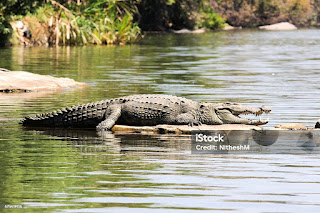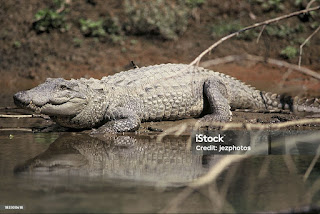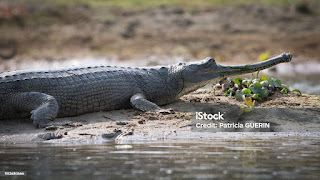17 जून को वर्ल्ड क्रोकोडाइल डे
India’s three main species of crocodilians.
1. The Estuarine or saltwater crocodile (Crocodylus porosus) : It is the largest living reptile on earth.
2. The mugger or marsh crocodile (Crocodylus palustris): Mugger or ‘makara’ in Hindu mythology is the vehicle of the river goddesses Ganga and Narmada.
3. The gharial (Gavialis gangeticus).
This family consists of 24 species and includes ‘true crocodiles’, alligators, caiman and the gharial.
------------------------------------------------------------------------------------------------------------------------
Saltwater crocodile (Crocodylus porosus):
The saltwater crocodile is found in only three locations in the country today: Bhitarkanika, the Sundarbans and the Andaman and Nicobar Islands.
The Gharial (Gavialis gangeticus):
The Gharial (Gavialis gangeticus) is a critically endangered crocodilian that had an original range in the river systems of India, Pakistan, Bangladesh and southern parts of Bhutan and Nepal.
Places: Gandak River, Bihar, India: वर्ल्ड वाइल्ड लाइफ के अधिकारी ने बताया कि गंडक नदी किनारे नौ जगहों पर घड़ियाल के अंडे पाए गए, जिसमें 8 स्थानों पर बिहार में अंडे मिले और एक यूपी के कुशीनगर क्षेत्र में. जिसके बाद किसानों के सहयोग से उसका संरक्षण किया गया (Year : 2023).
Valmiki Tiger Reserve, VTR comprises the Valmiki National Park and Valmiki Wildlife Sanctuary.
Boundaries: It is surrounded by the Royal Chitwan National Park of Nepal in the north and the river Gandak on the western side.
Location: It is located at the India-Nepal border in the West Champaran district of Bihar on the bank of river Gandak.
दरअसल इस वर्ष 2023 में गंडक नदी किनारे घड़ियालों के 9 घोंसले मिले थे, बगहा के धनहा-रतवल पुल के समीप घड़ियाल के अंडों के 5 घोंसले पाए गए थे, जिसमें से 4 घोसलों से 127 बच्चों का प्रजनन कराया गया. वहीं पहली मर्तबा बिहार के बगहा सीमा से सटे उत्तरप्रदेश के सोहगी बरवा के साधु घाट पर एक घोंसला पाया गया था जिसमें से 33 बच्चे निकले. एक घोंसला से अभी प्रजनन नहीं कराया गया है.
''यूपी के सोहगी बरवा में घड़ियाल के अंडों का जो घोंसला पाया गया है, वह मादा घड़ियाल नेपाल द्वारा छोड़ा गया था लेकिन माइग्रेट कर के वह बिहार यूपी सीमा पर चला आया है. ऐसे में माना जा रहा है कि गंडक नदी की आबोहवा घड़ियालों को खूब भा रहा है.''- वाइल्ड लाइफ ट्रस्ट ऑफ इंडिया
घड़ियालों की संख्या के मामले में गंडक नदी का दूसरा स्थान:
गौरतलब है कि 2016 में भारतीय प्रजाति के घड़ियालों का सर्वे हुआ था, जिसमें गंडक नदी में केवल एक दर्जन ही घड़ियाल मिले थे. जबकि अब इनकी संख्या तकरीबन 500 के आसपास हो गई है. तभी इनके बढ़ती संख्या को देखते हुए संवर्धन (पालन-पोषण ) के लिए सरकार ने कई प्रयास किए हैं. ऐसे में संख्या के लिहाज से देखा जाए तो भारत में चंबल नदी के बाद सबसे ज्यादा घड़ियालों की संख्या गंडक नदी में ही है.
Above Gandak River News source: https://www.etvbharat.com/hindi/delhi/bharat/125-gharial-babies-safely-released-into-gandak-river-in-bihar-bagaha/na20230617141759220220390
Mugger or marsh crocodile (Crocodylus palustris) in Chhattisgarh:
1. प्रदेश के जांजगीर चांपा जिले की अकलतरा क्षेत्र के कोटमीसोनार गांव, Mugger crocodiles in Kotmi Sonar, Chhattisgarh, कोटमीसोनार गांव में क्रोकोडाईल पार्क स्थापित है।
साल 2006 में बनाया गया क्रोकोडाइल पार्क,कोटमीसोना गांव के ज्यादातर तालाबों में पहले मगरमच्छों का अवास था। कई बार लोगों का आमना-सामना भी नहाने के दौरान मगरमछ़ों से हो जाता था। साल 2006 में सरकार ने यहां के तालाबों में बढ़ते मगरमच्छों की संख्या को देखते हुए क्रोकोडाइल पार्क स्थापित किया। अब वहां करीब 400 मगरमच्छ स्वतंत्र रूप से विचरण करते हैं। यह भी बताया जाता है कि चेन्नई के बाद देश का दूसरा सबसे बड़ा क्रोकोडाइल पार्क है।
About Kotmi Sonar:
Kotmi Sonar is a Village in Akaltara Tehsil in Janjgir-champa District of Chattisgarh State, India. It is located 56 KM towards west from District head quarters Janjgir, 9 KM from Akaltari, 133 KM from State capital Raipur
2. कांगेर घाटी राष्ट्रीय उद्यान: पार्क प्रबंधन के मुताबिक कांगेर नदी में 12 ऐसे प्वाइंट हैं जहां ये मगरमच्छ ज्यादा संख्या में पाए जाते हैं.
बस्तर में बहने वाला कांगेर नदी जिसे कुछ लोग विशाल नाला भी कहते हैं ये करीब 15 किलोमीटर लंबा है. कांगेर नदी कांगेर घाटी राष्ट्रीय उद्यान के बीच होकर निकलती है. करीब 15 किलोमीटर तक सीधी बहने के बाद ये नदी शबरी नदी में जाकर मिल जाती है. कांगेर नदी का पानी शबरी नदी में मिलता है और शबरी नदी का पानी 130 किलोमीटर बहने के बाद जाकर गोदावरी नदी में मिलता है.
Park includes Bhainsa Darha lake has crocodiles.
3. इंद्रावती नदी एवं विभिन्न नालों में मिलने वाले मगरमच्छ को कांगेर नदी में छोड़ा जा रहा है
4. छत्तीसगढ़ के रतनपुर के भीखमा तालाब @News Reports
5. पाली विखं का दक्षिण पश्चिमी हिस्सा खुटाघाट बांध से जुड़े हुए हैं खुटाघाट बांध में पाली विकासखंड के नदी नालों से पानी जाता है खुटाघाट बांध में बड़ी संख्या में मगरमच्छ है जो इन्हीं नदी नालों के सहारे कई बार यहां के आवासीय परिक्षेत्र तक पहुंच जाते हैं। @News Reports
Educational Purpose Only: The information provided on this blog is for general informational and educational purposes only. All content, including text, graphics, images, and other material contained on this blog, is intended to be a resource for learning and should not be considered as professional advice.
No Professional Advice: The content on this blog does not constitute professional advice, and you should not rely on it as a substitute for professional consultation, diagnosis, or treatment. Always seek the advice of a qualified professional with any questions you may have regarding a specific issue.
Accuracy of Information: While I strive to provide accurate and up-to-date information, I make no representations or warranties of any kind, express or implied, about the completeness, accuracy, reliability, suitability, or availability with respect to the blog or the information, products, services, or related graphics contained on the blog for any purpose. Any reliance you place on such information is therefore strictly at your own risk.
External Links: This blog may contain links to external websites that are not provided or maintained by or in any way affiliated with me. Please note that I do not guarantee the accuracy, relevance, timeliness, or completeness of any information on these external websites.
Personal Responsibility: Readers of this blog are encouraged to do their own research and consult with a professional before making any decisions based on the information provided. I am not responsible for any loss, injury, or damage that may result from the use of the information contained on this blog.
Contact: If you have any questions or concerns regarding this disclaimer, please feel free to contact me at my email: pradeep14335@gmail.com


